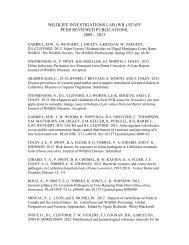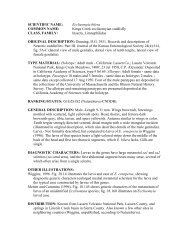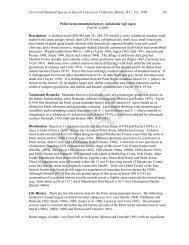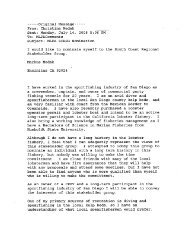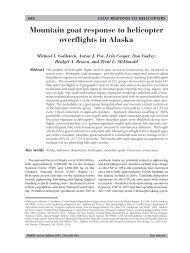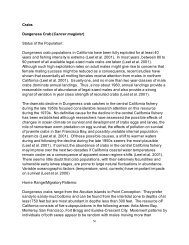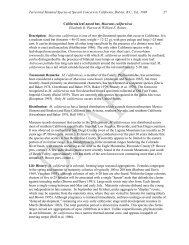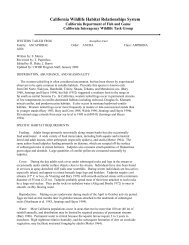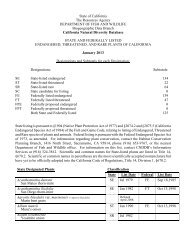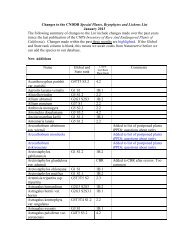Hermes copper - California Department of Fish and Game
Hermes copper - California Department of Fish and Game
Hermes copper - California Department of Fish and Game
You also want an ePaper? Increase the reach of your titles
YUMPU automatically turns print PDFs into web optimized ePapers that Google loves.
F<br />
Fluttering to<br />
xtinction<br />
Extinction<br />
Story <strong>and</strong> Photos by Daniel A. Marschalek
30 OUTDOOR CALIFORNIA<br />
F<br />
Fluttering to<br />
xtinction<br />
Extinction<br />
Story <strong>and</strong> Photos by Daniel A. Marschalek<br />
May - June 2012
O THER THAN ITS DIMINUTIVE SIZE AND BRIGHTLY COLORED<br />
WINGS, LITTLE WAS KNOWN ABOUT SOUTHERN CALIFORNIA'S<br />
FLIGHTY HERMES COPPER BUTTERFLY. RECENT DISCOVERIES OF NEW<br />
POPULATIONS FIRST DREW CELEBRATION AND THEN DESPAIR AS<br />
WILDFIRES SWEPT ACROSS THE SITES. NOW TIME IS RUNNING OUT<br />
TO LEARN MUCH MORE BEFORE FIRES CLAIM THE LAST BUTTERFLY.<br />
May - June 2012 OUTDOOR CALIFORNIA 31
With wings that measure a mere<br />
inch across <strong>and</strong> yet seem to<br />
sparkle in flight, the <strong>Hermes</strong><br />
<strong>copper</strong> butterfly (Lycaena hermes) appears<br />
as colorful as it is small. In 1930, William<br />
S. Wright, the curator <strong>of</strong> insects at the San<br />
Diego Natural History Museum, described<br />
the species in terms <strong>of</strong> a fanciful pixie.<br />
He wrote, “Its beautiful combination <strong>of</strong><br />
brown <strong>and</strong> yellow makes it a veritable<br />
fairy <strong>and</strong> gives untold joy to the collector<br />
fortunate enough to get one.”<br />
This rare butterfly species occurs only<br />
in the coastal sage scrub vegetation around<br />
San Diego <strong>and</strong> northern Mexico. It’s one<br />
<strong>of</strong> about 100 butterfly species present in<br />
San Diego County <strong>and</strong> about 170 in all <strong>of</strong><br />
<strong>California</strong>.<br />
Biologists recognize the <strong>Hermes</strong><br />
<strong>copper</strong> as a fascinating species because<br />
<strong>of</strong> several unique characteristics, but at<br />
the same time these characteristics may<br />
32 OUTDOOR CALIFORNIA<br />
contribute to its rareness. Nearly a century<br />
ago, experts raised concerns that the<br />
species may go extinct. Today, many <strong>of</strong><br />
those same concerns continue. In 1984,<br />
the U.S. <strong>Fish</strong> <strong>and</strong> Wildlife Service took the<br />
first steps in a long process to ensure the<br />
survival <strong>of</strong> the species when it labeled the<br />
<strong>Hermes</strong> <strong>copper</strong> a Category 2 designation<br />
under the Endangered Species Act.<br />
Over the decades, the decline <strong>of</strong><br />
the <strong>Hermes</strong> <strong>copper</strong> continued—but at<br />
a relatively slow pace—<strong>and</strong> warnings<br />
came from several sources. Wright, the<br />
museum curator <strong>of</strong> insects, wrote about<br />
the butterflies <strong>of</strong> San Diego County <strong>and</strong><br />
specifically stated that <strong>Hermes</strong> <strong>copper</strong><br />
faced possible extinction. Wright pointed<br />
to urban development as the threat to<br />
the butterfly’s habitat. Additionally, he<br />
<strong>of</strong>fered a prophetic warning that wildfires<br />
would pose a threat to the species <strong>and</strong><br />
their habitat. Over the decades, other<br />
biologists noticed that the numbers <strong>of</strong><br />
<strong>Hermes</strong> <strong>copper</strong> remained low, eventually<br />
leading to a 1991 petition to list <strong>Hermes</strong><br />
<strong>copper</strong> as an endangered species.<br />
Protection was denied due to lack <strong>of</strong><br />
biological data supporting threats to the<br />
species. Back then, little was known about<br />
<strong>Hermes</strong> <strong>copper</strong>, other than the species<br />
lived in only a h<strong>and</strong>ful <strong>of</strong> places <strong>and</strong> when<br />
researchers encountered the butterfly the<br />
numbers were always low.<br />
Alison Anderson, an entomologist<br />
with the U.S. <strong>Fish</strong> <strong>and</strong> Wildlife Service, said<br />
little information has been developed on<br />
<strong>Hermes</strong> <strong>copper</strong>.<br />
“Immature stages are difficult to find<br />
<strong>and</strong> many <strong>of</strong> their habitats were difficult<br />
to access historically due to the thick<br />
vegetation <strong>and</strong> rough or nonexistent<br />
roads,” Anderson says. “In addition, the<br />
limited distribution <strong>of</strong> <strong>Hermes</strong> <strong>copper</strong><br />
also contributes to our lack <strong>of</strong> knowledge.<br />
Because it is hard to find them where they<br />
are, <strong>and</strong> there are not a lot <strong>of</strong> places where<br />
they occur, biologists have not been able<br />
to learn much about their biology.”<br />
In 2002, the <strong>California</strong> <strong>Department</strong><br />
<strong>of</strong> <strong>Fish</strong> <strong>and</strong> <strong>Game</strong> launched an eight-year<br />
project in cooperation with San Diego<br />
State University to study the elusive<br />
butterfly <strong>and</strong> uncover more about the<br />
ecology. A researcher began collecting<br />
basic biological information <strong>and</strong><br />
discovered the only information available<br />
May - June 2012
came from a paper nearly four decades old;<br />
an author's general notes collected from<br />
field observations back in 1963.<br />
Faced with the lack <strong>of</strong> information,<br />
the DFG researcher quantified some <strong>of</strong><br />
the observations <strong>and</strong> addressed potential<br />
threats to help determine the status <strong>of</strong><br />
the species. The initial work took time<br />
but proved essential <strong>and</strong> allowed the new<br />
team <strong>of</strong> researchers the flexibility to adjust<br />
questions based on what was discovered<br />
during a previous year’s efforts.<br />
I<br />
In the summer <strong>of</strong> 2003, fieldwork started<br />
with developing a better underst<strong>and</strong>ing<br />
<strong>of</strong> basic biological characteristics <strong>of</strong><br />
<strong>Hermes</strong> <strong>copper</strong>. Researchers hoped to<br />
track when adult butterflies start to fly,<br />
locate where the butterflies are occurring<br />
<strong>and</strong> develop an accurate count. Because<br />
so little was known<br />
about the butterfly,<br />
researchers contacted<br />
local entomologists<br />
for suggestions on<br />
where they might<br />
see the species. They<br />
learned <strong>of</strong> four<br />
specific areas, all<br />
linked by an essential<br />
element necessary<br />
for the survival<br />
<strong>of</strong> <strong>Hermes</strong> <strong>copper</strong><br />
caterpillars.<br />
Diegan<br />
coastal sage scrub<br />
is the dominant<br />
vegetation<br />
association in the<br />
region’s upl<strong>and</strong><br />
open space <strong>and</strong><br />
spiny redberry is<br />
one <strong>of</strong> the species<br />
characterizing<br />
that community.<br />
Researchers<br />
learned spiny<br />
redberry is<br />
the only plant<br />
<strong>Hermes</strong> <strong>copper</strong><br />
caterpillars eat.<br />
Adult butterflies<br />
drink nectar<br />
from flowers<br />
through a strawlike<br />
mouth<br />
Once researchers net a butterfly in the<br />
field (below) they begin the examination<br />
as quickly as possible with the goal to<br />
lower the butterfly's stress level before<br />
release. To ensure detailed information<br />
is gathered properly, (at right) field<br />
specialists record identical data with<br />
each specimen. Notes are collected on<br />
the point <strong>of</strong> capture, as well as the date<br />
<strong>and</strong> time, the sex <strong>and</strong> the order taken.<br />
Researchers follow the same procedures<br />
for both initial <strong>and</strong> subsequent captures.<br />
coiled tight when they are not feeding.<br />
Although adult butterflies survive from a<br />
wide variety <strong>of</strong> flowers, caterpillars usually<br />
must feed on specific native plants.<br />
The four locations <strong>of</strong> spiny redberry<br />
where entomologists had recorded <strong>Hermes</strong><br />
<strong>copper</strong> were found <strong>and</strong> paths (transects)<br />
were marked. Researchers would later<br />
walk these transects <strong>and</strong> record butterfly<br />
numbers. Some required only a casual<br />
trail walk while other transects required<br />
pushing through thick shrubs. Having<br />
transects <strong>of</strong> equal lengths provided a fair<br />
way to compare butterfly numbers among<br />
different areas.<br />
Researchers elected to mark two<br />
additional transect locations with spiny<br />
redberry vegetation but without prior<br />
knowledge <strong>of</strong> <strong>Hermes</strong> <strong>copper</strong> presence.<br />
During the first summer <strong>Hermes</strong><br />
<strong>copper</strong> butterflies were found at all<br />
six locations, even the two new sites.<br />
Researchers recorded the butterflies from<br />
mid-May to early July. The number <strong>of</strong><br />
<strong>Hermes</strong> <strong>copper</strong> butterflies at each location<br />
varied a great deal. At one site in the<br />
Clevel<strong>and</strong> National Forest, researchers<br />
counted 75 in one day. However, at<br />
Sycamore Canyon County Park, a dozen<br />
miles to the west, the most ever observed<br />
in a single day was four.<br />
The discovery <strong>of</strong> two new populations<br />
provided hope that other populations<br />
existed <strong>and</strong> perhaps the species was not as<br />
imperiled as previously thought.<br />
Then in October 2003, following a<br />
successful field season, <strong>and</strong> as the species<br />
was in its egg-stage, wildfires raced<br />
through San Diego County. The inferno<br />
incinerated more than 280,000 acres <strong>of</strong><br />
May - June 2012 OUTDOOR CALIFORNIA 33
the foothills where <strong>Hermes</strong> <strong>copper</strong> existed.<br />
Inside the fire’s devastating footprint,<br />
flames consumed all the adults <strong>and</strong> all the<br />
butterfly eggs they had left attached to<br />
the lower branches <strong>of</strong> the spiny redberry<br />
shrubs.<br />
The destruction increased the concern<br />
over the status <strong>of</strong> the species. As the flames<br />
died <strong>and</strong> cleanup efforts began, even the<br />
media began questioning whether <strong>Hermes</strong><br />
<strong>copper</strong> still existed.<br />
When the team <strong>of</strong> researchers<br />
returned where they had established the<br />
study sites, they discovered five <strong>of</strong> the six<br />
destroyed. Habitat at the one untouched<br />
site indicated the butterfly eggs were not<br />
impacted.<br />
R<br />
Researchers regrouped <strong>and</strong> shifted<br />
focus from finding butterflies to<br />
finding new locations with spiny redberry.<br />
They reasoned <strong>Hermes</strong> <strong>copper</strong> would<br />
occur where the food source existed. And<br />
in this case, their reasoning proved correct.<br />
The discovery <strong>of</strong> the butterfly in the new<br />
location opened up a new line <strong>of</strong> research<br />
exploration—primarily how far will<br />
<strong>Hermes</strong> <strong>copper</strong> travel.<br />
To record butterfly movements,<br />
it’s important to separate <strong>and</strong> identify<br />
individuals. Researchers accomplish<br />
this by using a net to capture <strong>and</strong> then<br />
carefully maneuver the individual gently<br />
with a gloved h<strong>and</strong> so the butterfly’s<br />
wings are free from the net <strong>and</strong> fingers.<br />
The researcher uses a felt-tipped marker to<br />
place colored dots on the wings. Because<br />
<strong>Hermes</strong> <strong>copper</strong> butterflies generally perch<br />
on vegetation with their wings folded<br />
up above their body, color dots on the<br />
underside <strong>of</strong> the hind wing allow easy<br />
viewing.<br />
Collecting sighting with a global<br />
positioning system unit allowed the team<br />
to download all information at the end <strong>of</strong><br />
the summer to a computerized geographic<br />
information system, which calculated the<br />
distance between observations <strong>of</strong> each<br />
individual. Most <strong>of</strong> the marked individuals<br />
were considered territorial males that<br />
remained within a 30-foot radius. Still,<br />
readings showed a few adventurous<br />
individuals traveled as far as 600 feet.<br />
The marking study <strong>of</strong>fered a<br />
population estimate, which came in less<br />
than most other sites that year. Researchers<br />
marked 38 individuals over the course <strong>of</strong><br />
34 OUTDOOR CALIFORNIA<br />
the study with a one-day high <strong>of</strong> 20.<br />
To determine if the population size<br />
<strong>and</strong> movement patterns changed year-toyear,<br />
the marking study was repeated over<br />
four consecutive years. Yearly weather<br />
patterns can greatly affect the number <strong>of</strong><br />
butterflies observed in any particular year.<br />
Not surprisingly, the number <strong>of</strong> <strong>Hermes</strong><br />
<strong>copper</strong> butterflies increased in years with<br />
more seasonal rainfall <strong>and</strong> decreased<br />
during dry years. The likely connection<br />
suggests that more rainfall benefits the<br />
spiny redberry plant, which thrives<br />
with increased rains <strong>and</strong> produces more<br />
nutrition to the caterpillars.<br />
In October 2007, wildfires again<br />
ravaged San Diego County. This time<br />
flames scorched an even larger portion <strong>of</strong><br />
the county, including the study site found<br />
after the 2003 fire. Just like four years<br />
earlier, researchers had just completed a<br />
string <strong>of</strong> successful field seasons <strong>and</strong> the<br />
female <strong>Hermes</strong> <strong>copper</strong> had laid her eggs<br />
<strong>and</strong> attached them to the lower branches<br />
<strong>of</strong> the spiny redberry. The eggs stood no<br />
chance.<br />
Days or weeks later, however long it<br />
took for emergency personnel to allow<br />
people to reclaim what was left <strong>of</strong> their<br />
homes, their neighborhoods <strong>and</strong> the wide<br />
open foothills, the region appeared as<br />
desolate as the l<strong>and</strong>scape on the moon.<br />
Returning biologists sought the most basic<br />
<strong>of</strong> answers—where does <strong>Hermes</strong> <strong>copper</strong><br />
occur? How many locations—if any—<br />
survived? Clearly, it was evident they no<br />
longer occurred at sites where they once<br />
had.<br />
May - June 2012
There was always a chance the<br />
butterfly occurred somewhere that no<br />
one had found. Determining the current<br />
distribution <strong>of</strong> <strong>Hermes</strong> <strong>copper</strong> after two<br />
waves <strong>of</strong> large-scale wildfires was vital<br />
for assessing the status <strong>of</strong> the species.<br />
This developed into a timely topic after<br />
a second petition submitted to <strong>Fish</strong> <strong>and</strong><br />
Wildlife Service called to list the species<br />
under the Endangered Species Act.<br />
Accurately determining the status <strong>of</strong><br />
<strong>Hermes</strong> <strong>copper</strong> requires underst<strong>and</strong>ing<br />
where they are found today as well as<br />
where they were before urbanization<br />
<strong>and</strong> fires changed the l<strong>and</strong>scape. The<br />
only historical data available are pinned<br />
specimens on display at Southern<br />
<strong>California</strong> museums. The collections <strong>of</strong>fer<br />
detailed information concerning the<br />
The chances for researchers to<br />
establish an accurate population<br />
count <strong>of</strong> the <strong>Hermes</strong> <strong>copper</strong> seems<br />
questionable as its diminishing<br />
swath <strong>of</strong> habitat around San Diego<br />
continues to fuel the region's raging<br />
wildfires. Researchers fear the next<br />
sweeping firestorm could likely<br />
remove this delicate species from its<br />
only hold in <strong>California</strong>.<br />
date <strong>and</strong> location <strong>of</strong> historic populations.<br />
Interestingly, several collections date back<br />
to the early 1900s, <strong>and</strong> came from San<br />
Diego locations that now host shopping<br />
centers, hotels <strong>and</strong> a sports stadium. As<br />
San Diego’s l<strong>and</strong>scape changed over the<br />
years, the habitat <strong>of</strong> the <strong>Hermes</strong> <strong>copper</strong><br />
changed with it, effectively pushing the<br />
tiny butterfly out since 1950.<br />
R<br />
Researchers returned to the shrubcovered<br />
hillsides <strong>of</strong> San Diego County<br />
in 2008 to determine the current locations<br />
<strong>of</strong> the butterfly. They sought l<strong>and</strong> where<br />
spiny redberry shrubs grew <strong>and</strong> where<br />
permission to enter was granted. For the<br />
most part, they were restricted to public<br />
l<strong>and</strong>s such as DFG ecological reserves <strong>and</strong><br />
wildlife areas, as well as U.S. national forest<br />
l<strong>and</strong>s <strong>and</strong> federal wildlife refuges.<br />
A DFG researcher <strong>and</strong> a field crew<br />
under the guidance <strong>of</strong> San Diego State<br />
University pr<strong>of</strong>essor Douglas Deutschman<br />
searched more than 40 locations where<br />
they knew <strong>Hermes</strong> <strong>copper</strong> had existed<br />
at some point. They followed the same<br />
pattern to search for spiny redberry.<br />
Deutschman’s team made two<br />
important findings. First, when searching<br />
areas impacted by the 2003 or 2007<br />
wildfires, <strong>Hermes</strong> <strong>copper</strong> was found at<br />
only one location. Reestablishing a colony<br />
in an area ravaged by wildfires takes a long<br />
time, which leaves the species vulnerable<br />
to future fires. The second finding was<br />
that distribution <strong>of</strong> <strong>Hermes</strong> <strong>copper</strong> was<br />
the same in either a dry or wet year.<br />
Deutschman said local numbers were<br />
higher with more rain, but that fact did<br />
not result in the butterfly spreading to<br />
other locations.<br />
“The range <strong>of</strong> the species is very small<br />
<strong>and</strong> much <strong>of</strong> its prime habitat has burned<br />
in the last decade,” Deutschman says.<br />
The ability <strong>of</strong> the adult <strong>Hermes</strong><br />
<strong>copper</strong> to move across the l<strong>and</strong>scape is<br />
critical for the survival <strong>of</strong> the species<br />
because <strong>of</strong> the relatively high frequency<br />
<strong>of</strong> wildfires in the coastal sage scrub<br />
habitat. Butterflies must reestablish a<br />
population after the vegetation has<br />
recovered from a fire but they need to<br />
do it before a fire at the former location<br />
kills whatever population had stayed<br />
behind. The current existence <strong>of</strong> <strong>Hermes</strong><br />
<strong>copper</strong> provides evidence that the species<br />
has been able to survive in the fire-<br />
prone l<strong>and</strong>scape <strong>of</strong> Southern <strong>California</strong>.<br />
However, over the last century the<br />
l<strong>and</strong>scape has changed drastically for the<br />
butterfly. Additionally, shopping centers,<br />
hotels <strong>and</strong> sports stadiums could block<br />
their movements, which could prevent<br />
reestablishment <strong>of</strong> populations following<br />
wildfires.<br />
“The full life cycle <strong>of</strong> <strong>Hermes</strong> <strong>copper</strong> is<br />
poorly known,” Deutschman says. “Most<br />
<strong>of</strong> what we know is based on observing<br />
adult males. We know less about female<br />
behavior <strong>and</strong> habitat choice. We know<br />
almost nothing about the factors that<br />
influence the survival <strong>and</strong> growth <strong>of</strong> eggs<br />
<strong>and</strong> caterpillars.”<br />
Questions remain over the ecological<br />
requirements <strong>of</strong> <strong>Hermes</strong> <strong>copper</strong> that are<br />
critical for the survival <strong>of</strong> the species.<br />
Other than knowing the fact that<br />
caterpillars only eat spiny redberry, the<br />
larval requirements are unknown. The<br />
caterpillar stage is likely more vulnerable<br />
<strong>and</strong> sensitive to hardships compared to<br />
adult butterflies because <strong>of</strong> its immobility.<br />
Also related to food plants, it is unknown<br />
why <strong>Hermes</strong> <strong>copper</strong> is only found around<br />
San Diego when the plants that represent<br />
its food source are found throughout<br />
southern <strong>and</strong> central <strong>California</strong>.<br />
The determination to list <strong>Hermes</strong><br />
<strong>copper</strong> as threatened or endangered<br />
remains undecided. Decision makers<br />
are calling for more research to address<br />
habitat requirements <strong>and</strong> other biological<br />
characteristics. The research should<br />
provide key information for successful<br />
management <strong>and</strong> conservation <strong>of</strong> the<br />
species. And while a healthy ecosystem<br />
remains the key for natural resources<br />
management, the benefits spread to<br />
people who live in the area. Residents<br />
collect unspecified benefits when these<br />
natural communities function properly.<br />
Efforts to maintain all the plants <strong>and</strong><br />
animals within the designated areas help<br />
preserve the integrity <strong>and</strong> functionality<br />
<strong>of</strong> the ecosystems. DFG’s plan to continue<br />
its research on the <strong>Hermes</strong> <strong>copper</strong> will<br />
benefit this rare species <strong>and</strong>, at the same<br />
time, assist in preservation <strong>of</strong> other coastal<br />
sage scrub species.<br />
Daniel A. Marschalek serves as a scientific<br />
aid with the <strong>Department</strong> <strong>of</strong> <strong>Fish</strong> <strong>and</strong> <strong>Game</strong>.<br />
This is his first story in Outdoor <strong>California</strong>.<br />
May - June 2012 OUTDOOR CALIFORNIA 35



